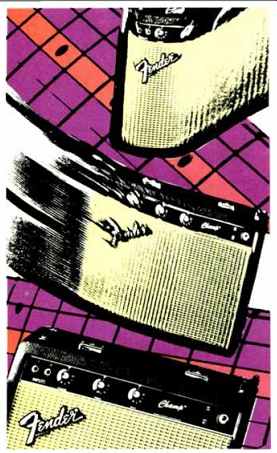HARMONIC CONTORTIONS

Running on Overdrive
Try as we may to avoid harmonic distortion in home playback equipment, it's an integral part of much modern pop music. Musicians of the '60s responded creatively to the overload characteristics of tube instrument amps by using the extra harmonics as a form of tonal enrichment--not just as a sign that the musicians were playing loud enough to bother our parents. The accepted wisdom in the rock world is that "typical amps sound best when they're run full out," according to Harry Kolbe of Harry Kolbe Soundsmith, an equipment manufacturer and modifier in New York. As a result, rock amplifier settings "are sheer Spinal Tap, with everything cranked full. This gives you a rich harmonic overload and 'sustain'--a harmonic composite, the amp singing over time, sounding like a saxophone or violin instead of a plucked string.
"The whole idea is to overdrive the amp as much as possible, from the input to the output stage. This, of course, generates a lot of harmonics, which are hopefully musically related. And that gives you the great big, fat, rock 'n' roll sound."
Overdriving only works because tube amps overload gracefully, gradually becoming more distorted as their level is increased, giving the musician a wide range of distortion levels to play with. The power versus distortion curves of modern transistor amps have sharper knees--a quicker transition from clean to clipping.
Full-tilt funk, however, is only available at full-tilt levels, through overloaded amps and their associated (usually built-in) speakers.
There are times when musicians need line-level signals, though. Instrument amps usually aren't loud enough to reach large audiences, so the musicians must play through big power amps and multiple speakers.
Overdriven instrument amps are also way too loud for comfortable recording in a studio, and recordings made by miking the instrument speakers rarely sound as clear as those made by direct feeds into the recording console.
The solution, in both cases, is to run a tube amp, full blast. into a dummy load that absorbs most of its power and then tap off a line-level signal to the house sound system or studio console. Until a year or two ago, resistive dummy loads were used, but these didn't yield the same sound from the amp as speaker loads do. Since then, more complex loads have appeared, such as Kolbe Soundsmith's Silent Speaker and others from Rocktron, Groove Tube, and one or two German companies.
Coils and capacitors bridged across such dummy loads' resistances simulate the induction, energy storage, and sometimes even the bandpass-filtering effects of yesteryear's rock speakers. The Silent Speaker, for example, "was patterned after a '412' Marshall cabinet," says Kolbe. "That's four 12-inch Celestion speakers together, probably the most-used cabinet in rock 'n' roll today. If you were to run an impedance curve on it, it would probably be within 10% of the Marshall's."
---------
Diverse Reflections

Diversity reception, a system which compares the signals from two spaced antennas and accepts the better of the two, has been around since it was invented in 1927 at RCA. Long in use for short-wave reception, it surfaced briefly in hi-fi about 20 years ago, in one H. H. Scott tuner, and has been recently revived for car stereo. (We tested diversity-equipped Blaupunkt and Clarion head units in Our May 1988 issue; Sony, last I heard, makes a diversity-tuned TV set for car use.) I'd been hoping it would resurface in home tuners or receivers. Sure enough, both Onkyo's T-909011 (reviewed in July 1988) and Akai's AT-93 (December 1988) have dual antenna inputs and automatic antenna selection. Unfortunately, that's not enough diversity to suit my needs. I'm an apartment dweller, forced to use indoor antennas in a high-multipath environment. When I move around my living room, the signal pattern changes, and any antenna orientation which brings good results when I stand in one spot works poorly when I shift to another.
To handle this problem, a diversity system needs to monitor its antennas' signals constantly, selecting and reselecting from moment to moment.
The Akai and Onkyo tuners both lock in their antenna choices when the station's first tuned in. That's fine for outdoor antennas or for antenna and cable, but not for indoor-antenna use.
(adapted from Audio magazine, Aug. 1989; by IVAN BERGER)
= = = =